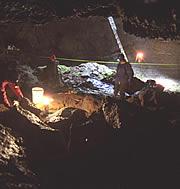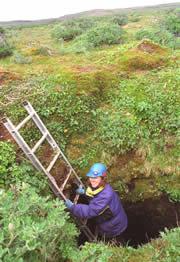 Inside the Qagnax cave during the 2003 excavation.© Douglas Veltre of the University of Alaska, Anchorage.
Inside the Qagnax cave during the 2003 excavation.© Douglas Veltre of the University of Alaska, Anchorage.Archaeologists have unearthed the most recent remains of a mammoth yet discovered in North America. The bones, found in a cave on Alaska's remote Pribilof Islands, may represent the last bastion of the giant animals, or megafauna, that once freely roamed the continent.
The discovery underscores the fact that megafaunal species often seem to have made their last stand on isolated islands, sheltered from the danger of hunting. Some say the fact that such animals survived longer when beyond the reach of humans is proof that mankind was a big factor in driving the beasts to extinction.
The bones date to around 5,700 radiocarbon years ago - at least 2,200 years younger than any other known North American mammoth, says Kristine Crossen, a geologist at the University of Alaska in Anchorage. She reported her team's findings this week at a meeting of the Geological Society of America in Salt Lake City, Utah.
Bags of bones
 The cave opens to a simple hole in the tundra, which Kristine Crossen descends by ladder© Douglas Veltre of the University of Alaska, Anchorage.
The cave opens to a simple hole in the tundra, which Kristine Crossen descends by ladder© Douglas Veltre of the University of Alaska, Anchorage.In 1999, hunters on St Paul Island literally stumbled across the cave: a 12-metre-deep pit in the Arctic tundra. Seeing a wealth of bones, they alerted university archaeologists Douglas Veltre and David Yesner. The team launched an expedition in 2003 to gather as much as they could from the sticky mud in the cave, which they named Qagnax, the native Aleut word for 'bone'.
In the course of a week, the researchers picked up more than 1,750 bones- most of them belonging to foxes that had fallen in and couldn't get out, says Crossen. But among the other animal bones were seven pieces of a mammoth, including two complete teeth.
The team dated the bones using different techniques at two separate laboratories. "We couldn't believe it at first," says Crossen.
Die hard
Mammoths died out on mainland Alaska around 11,500 radiocarbon years ago, the end of the Pleistocene epoch. But they are known to have lived longer elsewhere. Last year, other mammoth remains on St Paul Island were reported to be 7,900 radiocarbon years old1. And on Wrangel Island, off Siberia, their remains have been found dating as recently as 3,700 years ago.
Most of these island mammoths, including the St Paul animals, were smaller than normal - just 10% of the normal size range for a mammoth, says Crossen. The animals may have shrunk in size as the island itself shrank, losing ground as sea levels rose after the end of the last ice age.
 One of the mammoth teeth found in the cave.© Douglas Veltre of the University of Alaska, Anchorage.
One of the mammoth teeth found in the cave.© Douglas Veltre of the University of Alaska, Anchorage.Humans didn't arrive on St Paul Island until the late eighteenth century, so the mammoths must have become extinct from natural causes, experts say.
Archaeologists continue to debate the "overkill" theory, which holds that the first humans to arrive in North America hunted the continent's megafauna to extinction.
University of Alaska, Anchorage
-
References
- Guthrie R.D. et al. Nature, 429. 746 - 749 (2004). | ISI |
